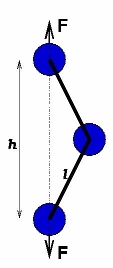Answer to Question 06/99
STRETCHED MOLECULEThe question was:
 A simple 3-atom molecule can be modeled as two infinitely rigid
rods ("bonds") of length l which are freely jointed,
i.e., the angle between those two rods can vary freely (see the picture).
The molecule is in thermal equilibrium
with its surrounding at temperature T.
With what force
F must the ends of the
molecule be pulled apart in order that the distance between the end-atoms be h?
(Obviously h < 2l.)
What is the origin of the resistance of the molecule to stretching?
A simple 3-atom molecule can be modeled as two infinitely rigid
rods ("bonds") of length l which are freely jointed,
i.e., the angle between those two rods can vary freely (see the picture).
The molecule is in thermal equilibrium
with its surrounding at temperature T.
With what force
F must the ends of the
molecule be pulled apart in order that the distance between the end-atoms be h?
(Obviously h < 2l.)
What is the origin of the resistance of the molecule to stretching?
(5/99) The problem has been solved (partially) by Andrew Wiggin (e-mail awiggin@hotmail.com).
The solution:
If the end atoms are held in place then the central atom can move in a circle of radius r=sqrt{l2-(h/2)2}. Thus the entropy of the system will be S=k ln(2{pi}r), so the configurational part of the free energy will be -TS. Taking a derivative with respect to h we find the force:
F=kTh/(4l2-h2)
While we usually say that "the force has entropic origin," the true mechanical reason is quite simple. At temperature T, the center atom will have mean kinetic energy (1/2)mv2=(1/2)kT. Since it is moving along a circle of radius r, it will need a centripetal force mv2/r =kT/r applied to it. A simple geometric calculation shows that the force F needed to create such centripetal force is exactly what we got above.
(By the way, this is exactly the principle on which the mechanical device called an inertial regulator is based: The change in speed of rotation changes the force F which is used to regulate the fuel supply to, say, a steam engine.)
 Back to "front page"
Back to "front page"